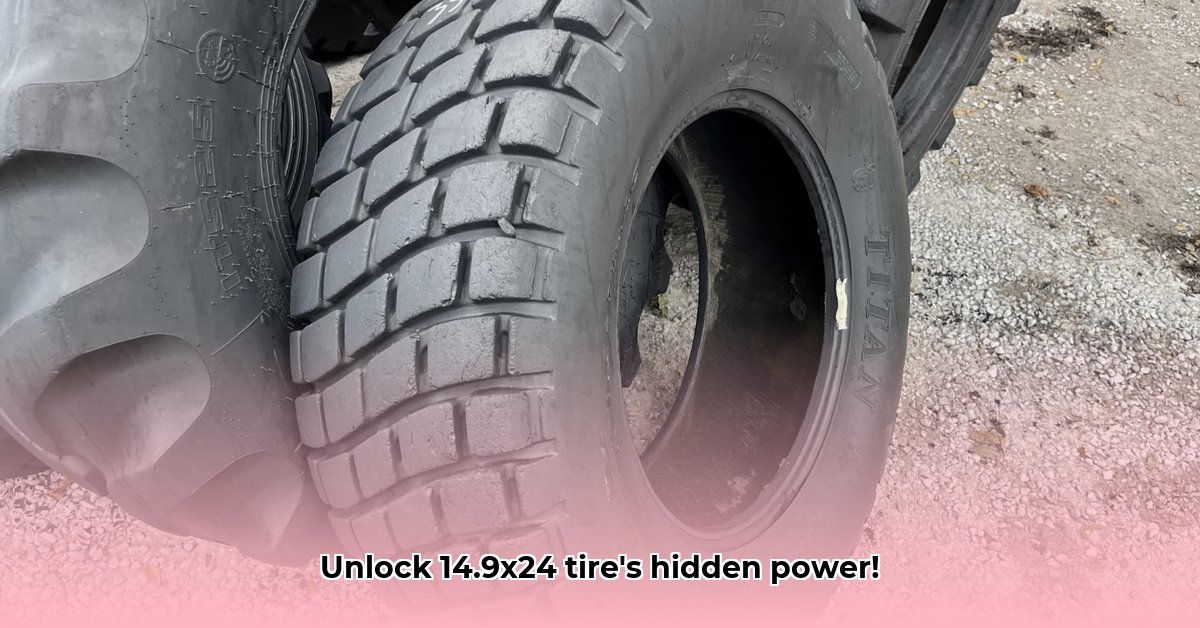
Choosing the right tractor tires is crucial for sustainable farming. This guide focuses on 14.9 x 24 tires, a common size impacting fuel efficiency, soil health, and operational costs. We’ll explore specifications, sustainable applications, and a cost-benefit analysis to help you make informed decisions. For specialized tire mounting equipment, check out this resource.
Understanding 14.9 x 24 Tractor Tires
14.9 x 24 tires are frequently found on versatile farm machinery, from smaller tractors to various implements. Their size provides a good balance of traction and maneuverability for diverse tasks. However, tire performance varies significantly. Understanding key specifications is paramount for maximizing efficiency and sustainability.
Tire Specifications and Technical Details
Several crucial aspects define 14.9 x 24 tire performance. The load capacity (maximum weight a tire can safely carry) is printed on the sidewall, along with recommended inflation pressure ranges. Different pressures are optimal for different loads and soil conditions. Tread patterns impact traction and soil interaction, While some manufacturers are using more sustainable rubber compounds, reducing environmental impact. Popular brands include Michelin, Firestone, and BKT, each offering variations in features and durability. Always consult the manufacturer's specifications for precise details. Isn't understanding these specifics essential for optimal performance and longevity?
Sustainable Agricultural Applications
The right tires are fundamental to sustainable farming practices. Let's explore their impact.
Minimizing Soil Compaction
Soil compaction reduces water infiltration, air circulation to roots, and ultimately, crop yields. Tire pressure is key. Excessive pressure concentrates weight, increasing compaction. Insufficient pressure leads to excessive flexing and similar problems. The ideal pressure is soil-dependent.
Here's a general guideline (always prioritize manufacturer recommendations and your soil testing):
| Soil Type | Recommended Inflation Pressure Range (%) | Considerations |
|---|---|---|
| Sandy | 80-90% | Adjust based on load and speed; easily compacted |
| Clay | 90-100% | Higher pressure often helps prevent slippage |
| Loam | 85-95% | A good compromise between the two extremes |
Fuel Efficiency and Emissions
Underinflation significantly increases rolling resistance, forcing the tractor to work harder and consume more fuel. This boosts both fuel costs and greenhouse gas emissions. Maintaining correct inflation, proper tread depth, and regular tire rotations directly contribute to fuel savings and reduced environmental impact. How much could you save annually with optimized tire pressure? The data suggests considerable savings.
Extending Tire Lifespan and Recycling
Regular inspections for cuts, irregular wear, and embedded objects are crucial for preventing premature tire failure. Tire rotation ensures even wear. Responsible disposal is paramount at the end of a tire's life, with recycling options readily available. Proper maintenance translates directly to cost savings and environmental responsibility. Isn't extending tire life a cost-effective and sustainable practice?
Cost-Benefit Analysis
While high-quality 14.9 x 24 tires have a higher initial cost, the long-term benefits far outweigh this expense. Reduced fuel consumption and extended tire lifespan quickly offset the investment. Minimized soil damage translates to enhanced yields. Consider the total cost of ownership for a comprehensive understanding of long-term savings.
Choosing the Right Tires for Your Farm
Tire selection depends heavily on your specific farm conditions. Soil type is paramount: clay requires different pressures than sandy soil. Climate significantly influences tire performance. The types of crops grown impact the necessary tire durability and traction. Consulting with tire specialists ensures you make an informed choice tailored to your farm's unique characteristics.
Conclusion: Investing in Sustainability
Choosing the right 14.9 x 24 tractor tires is a crucial investment in sustainable farming. Factors like tire pressure, tread patterns, and maintenance directly impact soil health, fuel efficiency, and environmental impact. By making informed decisions, you optimize performance, protect the environment, and enhance the long-term profitability of your farm. Are you ready to make sustainable tire choices for a healthier planet and more profitable farm?